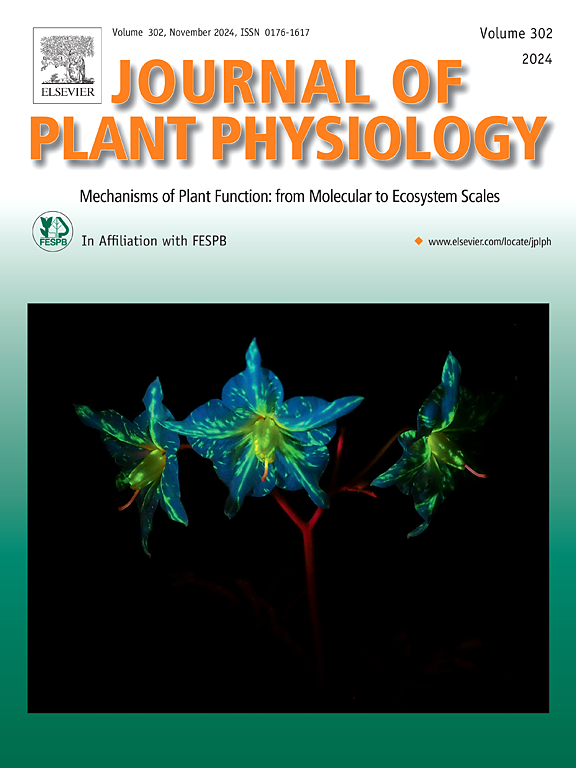Changes in the anthocyanin pathway related to phenolic compounds and gene expression in skin and pulp of cv. 'Istrska belica' (Olea europaea L.) during ripening
IF 4.1
3区 生物学
Q1 PLANT SCIENCES
引用次数: 0
Abstract
The purpose of research was to study in detail the dynamics of the anthocyanin pathway during the ripening of olives, comprising the relative gene expression of nine enzymes and the contents of twelve phenolic compounds. The analyses were conducted on cv. 'Istrska belica' at seven maturity stages, separately in the pulp and the skin. Most phenolic compounds showed a higher content in the skin than in the pulp. Results showed that the accumulation of dihidroquercetin and dihydromyricetin started at the latest maturity stages. The most abundant phenolics evaluated in the current study present in both tissues were cyanidin-3-O-rutinoside and delphinidin-3-O-glucoside, both presented at all maturity stages, even when colour was not yet visible in the skin or pulp. Gene expression of enzymes revealed tissue-specific regulation during ripening. Genes expressions for phenylalanine ammonia lyase, chalcone synthase, chalcone isomerase, flavonoid 3-hydroxylase and flavonoid 3′-hydroxylase showed higher levels in the skin than in the pulp, and an upregulation during ripening in both tissues. Anthocyanidin synthase was the only gene with the highest expression at the beginning of ripening, with extreme decrease between second and third maturity stage, which suggests that the enzyme is mainly synthesized at the beginning of ripening and that enzyme activation starts at latest maturity stages. Our research contributes to a better understanding of the dynamics of phenolic accumulation and the relative gene expression of enzymes involved in the anthocyanin pathway in reveals tissue-specific changes during olive fruit ripening. The previous results are also supported by physical changes, which are reflected in a statistical increase in fruit weight, a decrease in fruit firmness and also by changes in appearance observed during ripening. Understanding the accumulation of anthocyanins could, through further study, help to improve the quality of the fruit and therefore the quality of olive products.
欧洲油橄榄(Olea europaea L.)变种 "Istrska belica"(Istrska belica)果皮和果肉在成熟过程中与酚类化合物和基因表达有关的花青素途径的变化。
研究的目的是详细研究橄榄成熟过程中花青素途径的动态,包括九种酶的相对基因表达和十二种酚类化合物的含量。分析在七个成熟阶段对品种 "Istrska belica "进行,分别在果肉和果皮中进行。大多数酚类化合物在果皮中的含量高于在果肉中的含量。结果表明,二氢槲皮素和二氢杨梅素的积累始于最晚的成熟期。本研究评估的两种组织中含量最高的酚类物质是青花素-3-O-芸香糖苷和花翠素-3-O-葡萄糖苷,这两种物质在所有成熟阶段都会出现,即使果皮或果肉尚未显现颜色时也是如此。酶的基因表达显示了成熟过程中的组织特异性调节。苯丙氨酸氨裂解酶、查尔酮合成酶、查尔酮异构酶、类黄酮 3- 羟化酶和类黄酮 3'- 羟化酶的基因表达在果皮中的水平高于果肉,并且在成熟过程中在两种组织中都会上调。花青素合成酶是唯一一个在成熟初期表达量最高的基因,在第二和第三成熟阶段表达量极度下降,这表明该酶主要在成熟初期合成,酶的活化始于最晚成熟阶段。我们的研究有助于更好地理解橄榄果实成熟过程中酚类物质积累的动态变化,以及花青素途径相关酶的相对基因表达对组织特异性变化的揭示。物理变化也支持了之前的研究结果,这些变化反映在果实重量的统计增长、果实硬度的下降以及成熟过程中观察到的外观变化。通过进一步研究,了解花青素的积累有助于提高果实的质量,从而提高橄榄产品的质量。
本文章由计算机程序翻译,如有差异,请以英文原文为准。
求助全文
约1分钟内获得全文
求助全文
来源期刊

Journal of plant physiology
生物-植物科学
CiteScore
7.20
自引率
4.70%
发文量
196
审稿时长
32 days
期刊介绍:
The Journal of Plant Physiology is a broad-spectrum journal that welcomes high-quality submissions in all major areas of plant physiology, including plant biochemistry, functional biotechnology, computational and synthetic plant biology, growth and development, photosynthesis and respiration, transport and translocation, plant-microbe interactions, biotic and abiotic stress. Studies are welcome at all levels of integration ranging from molecules and cells to organisms and their environments and are expected to use state-of-the-art methodologies. Pure gene expression studies are not within the focus of our journal. To be considered for publication, papers must significantly contribute to the mechanistic understanding of physiological processes, and not be merely descriptive, or confirmatory of previous results. We encourage the submission of papers that explore the physiology of non-model as well as accepted model species and those that bridge basic and applied research. For instance, studies on agricultural plants that show new physiological mechanisms to improve agricultural efficiency are welcome. Studies performed under uncontrolled situations (e.g. field conditions) not providing mechanistic insight will not be considered for publication.
The Journal of Plant Physiology publishes several types of articles: Original Research Articles, Reviews, Perspectives Articles, and Short Communications. Reviews and Perspectives will be solicited by the Editors; unsolicited reviews are also welcome but only from authors with a strong track record in the field of the review. Original research papers comprise the majority of published contributions.
 求助内容:
求助内容: 应助结果提醒方式:
应助结果提醒方式:


